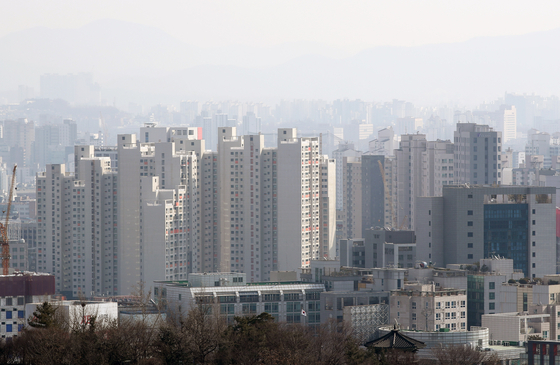![A view of Seoul apartment complex as viewed from Naksan Village, Changsin-dong, Jongno-gu, Seoul on January 31. [뉴스1]](https://i0.wp.com/pds.joins.com/news/component/htmlphoto_mmdata/202102/05/094df092-2010-4352-8d09-2d50b83b9d32.jpg?w=560&ssl=1)
A view of Seoul apartment complex as viewed from Naksan Village, Changsin-dong, Jongno-gu, Seoul on January 31. [뉴스1]
In the first week of February, apartment prices in Seoul rose the largest (based on the weekly increase rate) since the first week of July last year. In addition, the trading supply and demand index, which represents the sentiment of buying apartments in Seoul, also showed the highest figure since August of last year. Although the government has announced a large-scale housing supply, the apartment sales market in Seoul is getting hotter.
Weekly increase rate increases despite large-scale housing supply notice
According to the weekly apartment sales price trend in the first week of February (as of the 1st) of the Korea Real Estate Agency on the 5th, apartment prices in Seoul rose 0.10% from last week. This is the highest rate since the first week of July last year (0.11%).
The sentiment to buy an apartment is not declining. As of the 1st, the apartment sales supply and demand index in Seoul was 110.6, which was the highest since the second week of August last year (105.2). If the trading supply and demand index exceeds the threshold of 100, it means that the buying tax in the market is higher than the selling tax.
The results of the survey by Real Estate 114, a real estate information company, were similar. According to Real Estate 114, the sale price in Seoul rose 0.17% compared to last week. In the survey in the first week of January (as of January 29), the rate of increase in apartment prices in Seoul reached 0.15%, the highest level in one year, and the rise in the first week increased.
Seoul reconstruction apartments rose 0.25%. In Seoul this week, the price of apartments in 25 autonomous districts rose sharply due to anticipation of deregulation of urban maintenance projects in Gangnam (0.38%) and Songpa (0.19%).
All of the figures released this time were surveyed prior to the government’s announcement of the ‘2/4 supply plan’ on the 4th. Therefore, it is unreasonable to use it as a data to judge the effectiveness of measures. Experts predict that “the market’s reaction to the countermeasures will appear in earnest after the Lunar New Year holidays”. However, there are many prospects that it will not be able to stop the surge in apartment prices in the metropolitan area right away.
The plan is not to “supply 830,000 households that can be occupied” by 2025, but to “secure a site that can accommodate 830,000 households.” Depending on the type of house, it may be possible to move in within 5 years, but in most cases it will take 3 to 5 years to move in after securing the site.
“This measure is meaningful as a mid- to long-term supply measure,” said Doo Seong-gyu, a senior researcher at the Korea Institute of Construction Industry. It is regrettable that there was no point.”
Lim Byeong-cheol, senior researcher at Real Estate 114, also analyzed that “considering the fact that public-led supplies take time to actually supply them, it may act as a limit to prevent the immediate rise in house prices and the surge in rental prices.”
Reporter Kim Won [email protected]
